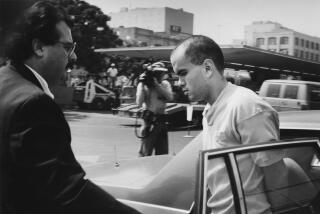Unzipped
- Share via
Too bad “gender” is such a dull word. One thinks immediately of grammar or those arid academic discussions so difficult to read, which seem to have no bearing on anything that matters. Too bad also that no other word exists to make a distinction between what is biologically given to men and women and what gender is meant to define: received ideas about masculinity and femininity that enter us unbidden and determine who we imagine, or wish, ourselves to be.
This is not a boring subject. Think of Stanley Kubrick’s new film, for instance, “Eyes Wide Shut.” Recently I sat on the edge of my seat in the darkness of a theater as a succession of dazzling images revealed the virtual life of a mind hypnotized not by events so much as by ideas of sexuality, propriety, desire. Though the force of the imagination creates an irresistible, thrilling and, at the same time, hellish world, one is led to feel that what is not real matters as much as what is.
What is imagined is as much the subject of Susan Bordo’s “The Male Body” as what is flesh. (Though, of course, the distinction blurs. Whatever is imagined, especially about sexuality, soon enters reality, shaping society, individual behavior and even the body itself.) Indeed, Bordo, a critic and a philosopher of contemporary popular culture, writes far less about the flesh than about the narratives of flesh in which we all find ourselves imprisoned. With an almost chatty style, but also possessing a subtle power, her book transforms our habitual understanding of movies, advertisements, novels and even trends and toys.
Bordo’s focus is less on the body than on culture itself. Even when she is describing physiology, her emphasis is on how we see the body. “Human flesh is particularly vulnerable,” she writes, “but the soft penis seems especially so, not, I think, because (like the testicles) it is more easily hurt than other parts of the body, but by virtue of contrast with its erect state.”
In “Private Parts,” the first section of her book, any discussion of the penis itself is entirely overshadowed by images of the organ in popular culture. This is, of course, fitting. At least in modern industrial societies, the idea of the penis has far outrivaled the real McCoy, which until very recently was seldom exhibited. We read about Ken, for instance, of the famous Ken and Barbie dyad, that the bulge in his groin and how big it should be were the subjects of intense debate at Mattel. As well as pointing out the absence in the last 100 years of visible penises in a landscape of popular imagery that included much more female flesh, Bordo traces the (so to speak) upward curve of a trend among more recent ads and films to reveal more and more of the bulge, if not, at times, the genuine article.
Yet if, in her writing, the body is present mostly as image and construct, Bordo’s book is still about flesh, at least insofar as we can possibly know it. Even in uncensored anatomical descriptions of the body, there will always be a veil, always some impediment. And the prejudices and manners of culture which distort and obscure reality also enhance physical experience. The mind in the end is also part of the body.
Of course, the paucity of descriptions of masculine sensuality in this book has another obvious cause. Early in the text Bordo points out the necessary limitations of her own experience. Not being a man, she cannot feel what a male body feels. Instead, she tells us, she will speak from her own experience, that of a woman who is attracted to men. (Jane Austen knew that such limitations can be turned to advantage.) Through her own desire, Bordo finds the charged places, the cultural nerve endings that drive us all.
She begins the book with a short biography of her father, written entirely from her point of view. This first chapter, by far the most gracefully written, is also the most moving. Her descriptions of her childhood memories are complexly nuanced and vivid. One feels the heated love of a daughter for her father. And her fascination with him, followed by disillusionment and loss, are inseparable from the portrait she renders. But here again what might be a confusion and conflation of subjects becomes a strength as Bordo makes it clear, both in articulated theory and by example, that the masculine body cannot be understood apart from cultural fabrications of the feminine body. As much as some would argue from either side of the gender divide that an unbridgeable gap exists between men and women, the modern construction of the male body in popular culture has evolved in tandem with the contemporary images of the female body.
And the reverse is also true. She weaves her own early experiences of a developing sexuality throughout her discussion of the invisibility of the penis in the ‘50s and ‘60s (even as a bulge in an ad for underwear), bringing us to understand how powerfully this invisibility has affected the sexual imagination of women. “If one didn’t get to see one at home or in the back seat of a car, where did a girl get to see one?” she writes in the witty tone that characterizes the book. Later, speculating, rightly I believe, that the disinterest many women have shown in the pleasure of seeing the male body (or indeed the female body) does not have a biological etiology but has occurred instead because we have been given constant cultural cues that this pleasure is forbidden us.
*
Indeed, Bordo’s discussion of the differences between men and women in general is one of the best I have read anywhere. She takes on the idea that men are from Mars and women from Venus with calm clarity, pointing out, for example, how cultural conditioning can shape biology itself, even testosterone levels. Her approach is balanced. Parting company with the school of feminism fashionable in academia in the early 1990s that argued that no difference exists, she writes that this approach erases evolutionary history. (It is interesting that when explaining human behavior, both extremes--nature and nurture--seem to deny the earthly dimensions of our existence.) She is, however, part of the current trend in feminism that argues that one cannot understand women’s lives apart from men’s lives.
Examining images of men, whether in film, advertisements, novels or television, Bordo explores the masculine experience of many issues--sexual harassment, objectification in pornography, rape--that have been raised and articulated by women. Dispensing with the old polarities between men and women, her approach turns up clarifying insights--the observation, for instance, that because few men are able to attract women who are considered perfectly beautiful, the idealized image of a woman’s body produces disappointment and failure for men as well as women.
“The Male Body” mines the territory of popular culture with subtle insight, revealing a wealth of meaning to things that (to quote scholar Richard Bienvenu on the work of cultural historian Phillippe Perrot) “only seem inconsequential and trivial.” But there are disappointments, places in which she might have gone even deeper beneath the apparent surface. An entire chapter on Nabokov’s “Lolita,” for example, which contains a lengthy comparison of Kubrick’s and Adrian Lyne’s film versions, and which seems oddly disconnected to the rest of the work, attempts but ultimately fails to connect a consideration of the sexual abuse of children and its motivations to the social constructions of masculinity she has elucidated earlier. In the end, considering the gravity of this issue, her discussion seems superficial and almost light.
And, along those lines, something else is missing from this otherwise marvelous book: a look at the more disturbing consequences of gender, that nightmarish side that can be felt so powerfully in the terrifying atmosphere of Kubrick’s last film. This lack is evident in her discussion of pornography. What she offers is valuable: the idea that in presenting images of some women who declare, “[H]ere I am . . . utterly available to you, ready to be and do whatever you desire,” men might feel a relief from the constant temptations of female beauty and the humiliation of rejection. The intent of what has been called the objectification of women, she says, is less to erase female will and identity than to offer an unmitigated acceptance of desire. But she does not go on to consider how such images, which in fact do erase female autonomy, might contribute to sexual aggression and violence toward women.
In fact, despite popular culture’s association between violence and masculine sexuality, Bordo seems mostly to avoid the subject of violence. I am reminded of another film, “Affliction,” based on a Russell Banks novel, which makes a heartbreaking connection between the brutality that fathers wreak on their sons and the violence men wreck upon women. Such a discussion would not only have widened the range of her insights, it would have given the whole book a larger context. Still, I am grateful for this book. Bordo’s talent for reading culture presents us with the most valuable gift: a newly configured imagination. *
More to Read
Sign up for our Book Club newsletter
Get the latest news, events and more from the Los Angeles Times Book Club, and help us get L.A. reading and talking.
You may occasionally receive promotional content from the Los Angeles Times.










